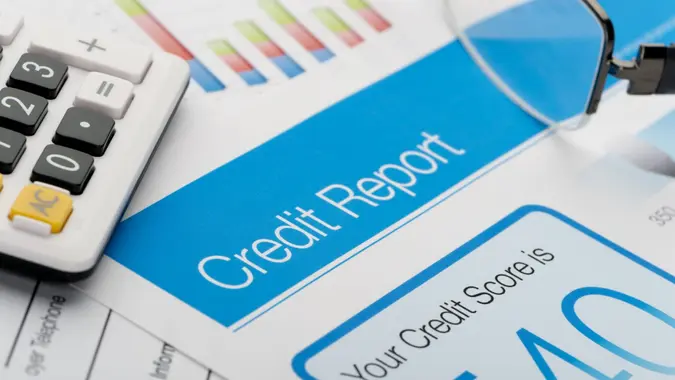4 Common Ways Middle Class People Hurt Their Credit Scores

Commitment to Our Readers
GOBankingRates' editorial team is committed to bringing you unbiased reviews and information. We use data-driven methodologies to evaluate financial products and services - our reviews and ratings are not influenced by advertisers. You can read more about our editorial guidelines and our products and services review methodology.

20 Years
Helping You Live Richer

Reviewed
by Experts

Trusted by
Millions of Readers
Many middle class people unknowingly hurt their credit scores, impacting their ability to borrow money and build wealth. When you go to buy a home, you might be surprised to find out your credit is less than stellar. However, the good news is that monitoring your credit and improving your credit score is possible and straightforward.
Here are some ways middle-class people hurt their credit score and a solution for how to fix each one.
Not Checking Credit Reports
Everyone is entitled to a free credit report from the three major credit bureaus: TransUnion, Equifax, and Experian. You can access your credit report by visiting the Annual Credit Report website. Just type in your name, social security number and address to access your account.
Once you do, open your credit report and scan it for errors.
For example, make sure every account listed on your credit report is yours. Also, ensure your name and address are correct. Credit report errors can happen, so ensuring you’re not unknowingly paying for someone else’s mistakes is a good idea.
Solution
Make a note in your calendar to check your credit report annually but preferably every quarter. Take the time to review each account, and pay special attention to accounts that are in collections.
If you have adverse accounts, call the number listed next to them and speak with someone who might be able to help you settle and get it cleared from your credit report.
Ultimately, monitoring your credit report regularly can help you maintain or improve your credit score simply by checking for accuracy and handling adverse accounts.
Not Paying Bills On Time
Your payment history makes up 35% of your credit score. It is the largest portion of your credit score, which means it has the biggest impact on your credit.
There’s a good reason for this. When you apply for credit, lenders will look at your credit history to see if you have a history of paying your bills on time. Much like you wouldn’t want to loan money to a friend who never pays you back, lenders are more hesitant to give credit to people with a poor payment history.
Solution
Make sure to pay your bills on time every time. If you can’t pay a bill, call your provider, whether it’s your electric or car loan company and let them know that you’re experiencing financial hardship. Often, companies have temporary solutions for this type of issue and working with them can help prevent negative marks on your credit report.
Those phone calls are hard to make, but they could save your credit in the long run.
Maxing Out Credit Cards
The next most significant portion of your credit score is debt owed, which is 30% of your credit score. This is also sometimes called your debt-to-credit ratio or credit utilization ratio. This measures the amount of credit you use against the amount lenders have extended.
You’ll have a more favorable credit score if you utilize 30% or less of your available credit. However, if you max out your credit cards by utilizing all your available credit, lenders see you as a riskier borrower and might not extend a loan offer.
Solution
If you’re using a high percentage of your credit, work to lower it to where you only utilize 30% or less of your available credit. In most cases, you will see a credit score increase when that happens.
Ideally, paying off your credit cards in full every month is a best practice due to the high interest rates, but starting by lowering your balances can greatly improve your score.
Co-signing Loans
Co-signing a loan for someone else is a very generous offer. However, if the person you’re helping does not pay their bills on time, you are liable for their payments. If you can’t make those payments, it shows as missed payments on your credit report, even if the loan was for someone else.
It’s prudent to be cautious when offering to co-sign a loan for somebody.
Solution
It’s best to avoid cosigning loans, especially co-signing loans to friends or significant others you’re not married to.
However, if you decide to cosign a loan for your spouse, child, or close family member, go into it with the mindset that it’s your loan.
Have the money set aside ready to pay each month if they need help making payments. In other words, co-signing a loan is something you can do when you are financially secure and able to make payments for somebody else if it becomes necessary.
Final Thoughts
A high credit score is good for many reasons, including securing loans for life’s biggest purchases, like cars or a house. Plus, having a good credit score can save you money. The better your credit score is, the more competitive interest rates you’ll be eligible for.
It’s important to be aware of some common mistakes middle-class people make that hurt their credit scores. If you have made one of the mistakes above, try out the recommended solution to improve your finances in the future.
More From GOBankingRates
 Written by
Written by  Edited by
Edited by 























